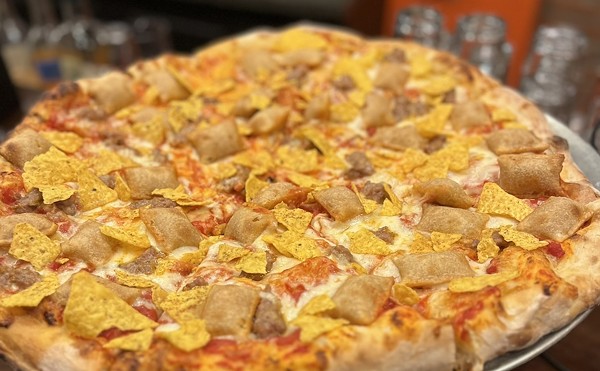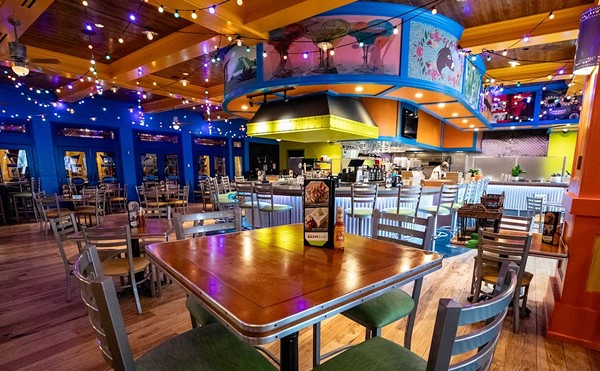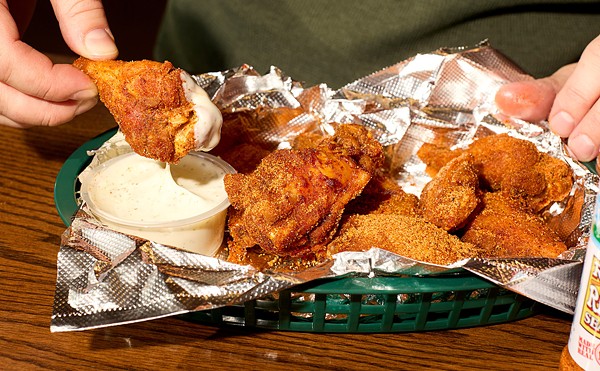Zu Zu's Petals, housed in the former Jeremiah's, in Kirkwood, is named for a scene in the movie It's a Wonderful Life in which Jimmy Stewart's character jubilantly discovers in his pocket petals from his daughter Zuzu's rose. Chef David Slay, executive chef and part owner of the restaurant, must live up to his own culinary reputation and that of his family -- Lisa Slay, chef at Remy's Kitchen & Wine Bar, is his sister, and Steve Komorek, chef at Trattoria Marcella, is his cousin. David Slay's previous successes in St. Louis include Café Hampton, La Veranda and the Seven Gables Inn. And in 1989 he moved to Beverly Hills and opened David Slay's La Veranda, his name a preamble to the restaurant's name like a Hollywood director's imprimatur preceding the title of a movie.
Zu Zu's serves international cuisine, with influences from Asia, the Mediterranean, Italy, France and the American Southwest. Drawing on varied ingredients and his own buoyant imagination, Slay brings everyone on board: The restaurant's dishes are familiar enough to attract prosperous suburbanites from the surrounding community yet novel enough to generate a buzz among flighty been-there-done-that urban diners. One nod to the neighborhood demographics is a prominent children's menu, headed "Small Appetites," which you might mistake for a Remy's-style tapas list until you realize that chicken fingers and buttered noodles can in no way be considered cool.
The menu is exceptionally sophisticated and balanced but occasionally capsizes during execution. For example, the slender chicken-apple sausages were dry, with leathery casings and disappointingly tame spices. The ropy links were presented on a slurry of undercooked cannellini beans, or Italian white kidney beans, tossed in tomato-basil sauce. Another dish that turned turtle was the 14-ounce ribeye, marinated in a poultice of blackstrap molasses and Asian spices. Although my companion ordered the steak medium, it arrived almost rare, and the marinade was barely perceptible.
But most dishes are in no danger of foundering. Smooth mussels, not a fishy specimen among them, are paired with delicate ringlets of pasta called ditalini, swaddled in the same tomato sauce used with the white beans. Carpaccio, a first course of velvety, thinly sliced raw beef, is named for the Italian artist Vittore Carpaccio, who was fond of using red paint on his canvases. At Zu Zu's, the beef is spread with black caviar and golden caviar, a whitefish roe tinged green with sharply flavored wasabi, sometimes described as Japanese horseradish. The slippery beads of caviar burst against your palate, giving you the gleeful satisfaction you felt as a child when you popped the air pockets on a piece of bubble wrap. Another starter, onion soup cloaked in mild, soapy-tasting Gruyère cheese, is the loamy color of bracing coffee, but it's deceptively sweet, as though a lump or two of sugar had been plunked into the hot broth.
Sea bass, which has always fetched a dear price in Europe, is among the best entrées at Zu Zu's. When this fish is properly cooked, it has a gauzy texture that seems to dissolve on the tongue. Slay's no-fuss "bronzed" preparation is just the right way to treat sea bass, with no spices, coatings or heavy sear to mask the clean flavor of its snowy flesh. A dome of couscous studded with dried cherries, red and green bell peppers and toasted pine nuts gives the plate some height, and a tomato-caper relish with green olives, basil, onions, artichoke crowns and paprika has unexpected piquancy.
Zu Zu's pastry chef, Brenda Sias, also walks a fine line between the habitual and the hip. Her chocolate crème brèlée cuffs you with intense cocoa flavor and brings you around again with a silky, pleasantly weighty mouth feel similar to that of cake frosting. Her cranberry croissant bread pudding has a delightfully squishy springiness, and the acidity of the cranberries cuts the lushness of the egg-soaked pastry. However, Sias has overreckoned diners' yen for cranberries: Three of the four desserts we sampled were made or garnished with them.
Zu Zu's romantic setting is neither mawkish nor stiflingly opulent, and somehow it makes you feel almost obligated to overindulge. The restaurant has several lovely dining spaces, but ask to be seated in the piano room or in the alcove, a sequestered space with warm sage-green and salmon-pink walls. The low lights in this room make the attractively presented food look especially alluring. Swathed seductively in their lettuce leaf and awash in glimmering candlelight, even the homely poppers look positively ravishing.





